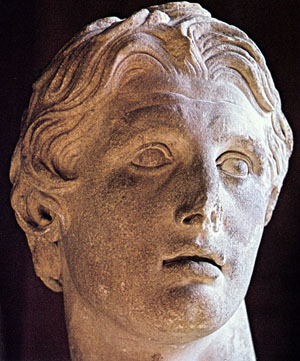
Portrait of Alexander the Great (?)
from Pergamon
1st half of 2nd century BCE
Marble, height 161/8"
(Archaeological Museum, Istanbul)
Philip II (359-336 BCE) of Macedonia implemented the ideal of a united Greece. During his reign the Macedonian state grew
considerably in power. After his assassination in 336 BCE, he was succeeded by his son, Alexander, whose achievements have caused him to be regarded as one of the most outstanding figures in the history of the world.
Alexander's Eastern campaigns began in 334. Between 334 to 332, he conquered the Persian provinces of Asia Minor then Syria and Egypt. He then defeated the King of Persia in 331, which left him in control of Persia and Mesopotamia. He continued further East to the borders of India. His army, however, would travel no further East, and he returned West, conquering along a southerly route. He
reached Babylon in 323 where he died of a fever at the age of 32 or 33.
Alexander the Great left no heir and his vast empire was left for his generals to divide up. The struggle for power and territory lasted for about 40 years. By about 275 BCE three major divisions of Alexander's empire had become more or less established. Smallest kingdom included Macedonia and European Greece - ruled by the Antagonid dynasty. Athens now politically unimportant (capital of the
Antagonid kingdom was Pella in Macedonia). Athens became a university town and cultural centre, and benefitted materially from gifts of buildings and sculpture given by Hellenistic kings who had studied there in their youth. Athens fell to the Romans in the Sack of Sulla in 88 BCE.

The Hellenistic Empires about 275 BCE
The Seleucid kingdom included most of Alexander's eastern territory. Its capital was Antioch. The Seleucid kingdom fell to the Romans in 65 BCE.
Egypt was taken by Ptolemy, one of Alexander's more astute generals, who founded a stable dynasty that lasted down to its last queen, Cleopatra. She lost her throne to the Romans in 30 BCE.
The Hellenistic period was one of constant conflict among the great states, especially between the Ptolemies and the Seleucids. During these struggles, a city could often seize an opportunity to become independent (for example, Pergamon on the northwest coast of Turkey, and Rhodes. Both became commercially prosperous and centres of some of the most original Hellenistic art).
The extension of Greek culture to other lands is a distinguishing feature of the time and the quality that gives the period its name. Essentially a new culture was formed, more secular and cosmopolitan than the old. It was this culture that so influenced Rome, and through it the Western world. The Hellenistic kingdoms were ultimately absorbed by Rome, whose empire was greater than
Alexander's and which gave the world almost 200 years of relative peace.
In the new world that Alexander had created a new art was produced. This new art came about largely as a result of the increased contact Greece now had with other lands and peoples. Staggering variety of art of this period, which lasted almost 300 years and covered a geographical area stretching from Greece and Egypt in the West to India in the East. Very rich, and difficult to grasp and
understand fully.
The Hellensitic Period can be dividied roughly into three phases:
- 3rd. century BCE - essentially a continuation of 4th-century styles
- 2nd. century BCE - the period of Pergamon, and the "Hellenistic Baroque"
- 1st. century BCE - dominated by Rome
In the history of Greek art we have seen a relatively constant development toward a realistic representation of nature. In the Hellenistic
period, this development reached a certain climax. For the first time all classes of society and all gradations of physical condition were
realistically shown. Technically, Greek art had never achieved such heights.
|

 SPRING 2016
SPRING 2016  SCHEDULE
SCHEDULE  REQUIREMENTS
REQUIREMENTS

 SPRING 2016
SPRING 2016  SCHEDULE
SCHEDULE  REQUIREMENTS
REQUIREMENTS